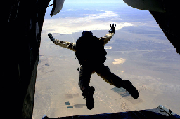| THERMO Spoken Here! ~ J. Pohl © | TOC NEXT ~ 48 |
Parachutist's Drag Force

Some time after jumping from an aircraftt the acceleration of a parachutist becomes 6.8 m/s². The mass of the man is 90 kilograms. Calculate the frictional drag force of the surrounding air at that instance of the fall?
Note: A short moment after the parachutist jumps (@ t = 0+) horizontal speed will be that of the aircraft, his vertical spped will be zero and his acceleration will be Earthward at 9.8m/s², the velocity downward is zero and so also is the resistance of surrounding air. Speed of fall through air increases, hence air resistance to that motion increases. Ultimately the speed of fall becomes "all the surrounding air" will permit... terminal velocity is attained.
Solution: The term "force" is a signal that Newton's 2'nd Law applied to some "BODY" is the consideration. The physical property of the 2'nd Law is the momentum of the BODY.

| (1)(1) |
Acceleration, (not a property but a spatial characteristic) of a BODY is relevant for systems having constant mass. The 2'nd Law for the parachutist (as a mass) in this case has two forces acting: that of gravity and fluid resistance or drag.

| (2)(2) |
A system sketch should have been drawn with the person modeled as a BODY and the forces acting. Acceleration and forces are vectors; coordinates and a vector basis are required to state them. The sketch ( not done) would show the coordinates 0XZ with unit vectors I - J - K (with K upward or in the positive Z direction). The acceleration and gravity force are in the negative K direction. In the vector equation below, the drag force, its magnitude and direction, are the unknowns.

| (3)(3) |
The above equation has only one unknown entity. So do algebra and calculator.

| (4)(4) |
So, Newton's 2'nd Law, being a vector equation, states the force to have a magnitude of 270 Newtons and to be directed upward.
Parachutist's Drag Force
 At the precise instance of leap, the acceleration is Earthward at 9.8m/s². A
few moments later, in free fall, the acceleration of a parachutist becomes 6.8 m/s². The mass of the person is 90 kilograms. Calculate the frictional drag force of the surrounding air at that instance of the fall?
At the precise instance of leap, the acceleration is Earthward at 9.8m/s². A
few moments later, in free fall, the acceleration of a parachutist becomes 6.8 m/s². The mass of the person is 90 kilograms. Calculate the frictional drag force of the surrounding air at that instance of the fall?
Premise presently unwritted!